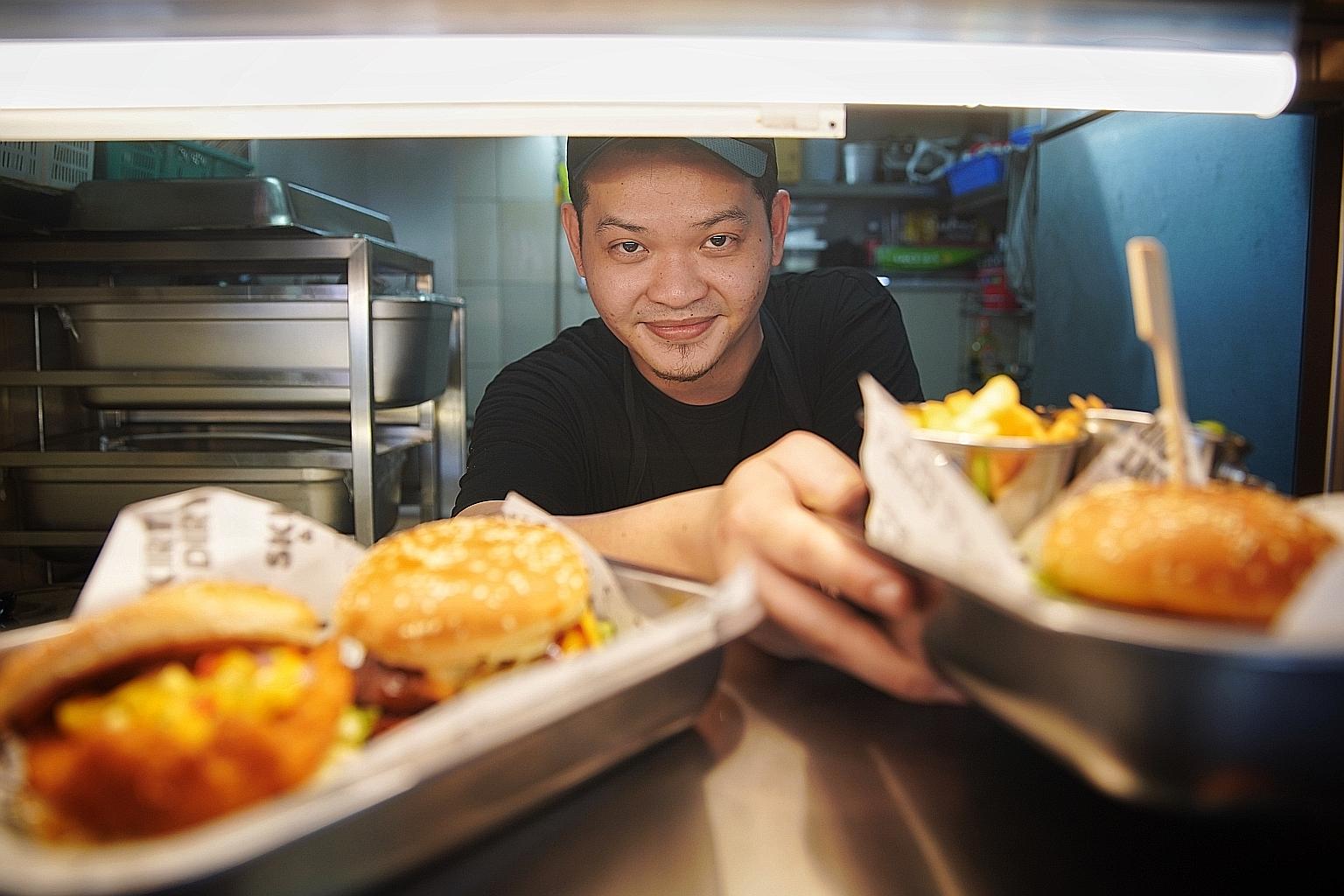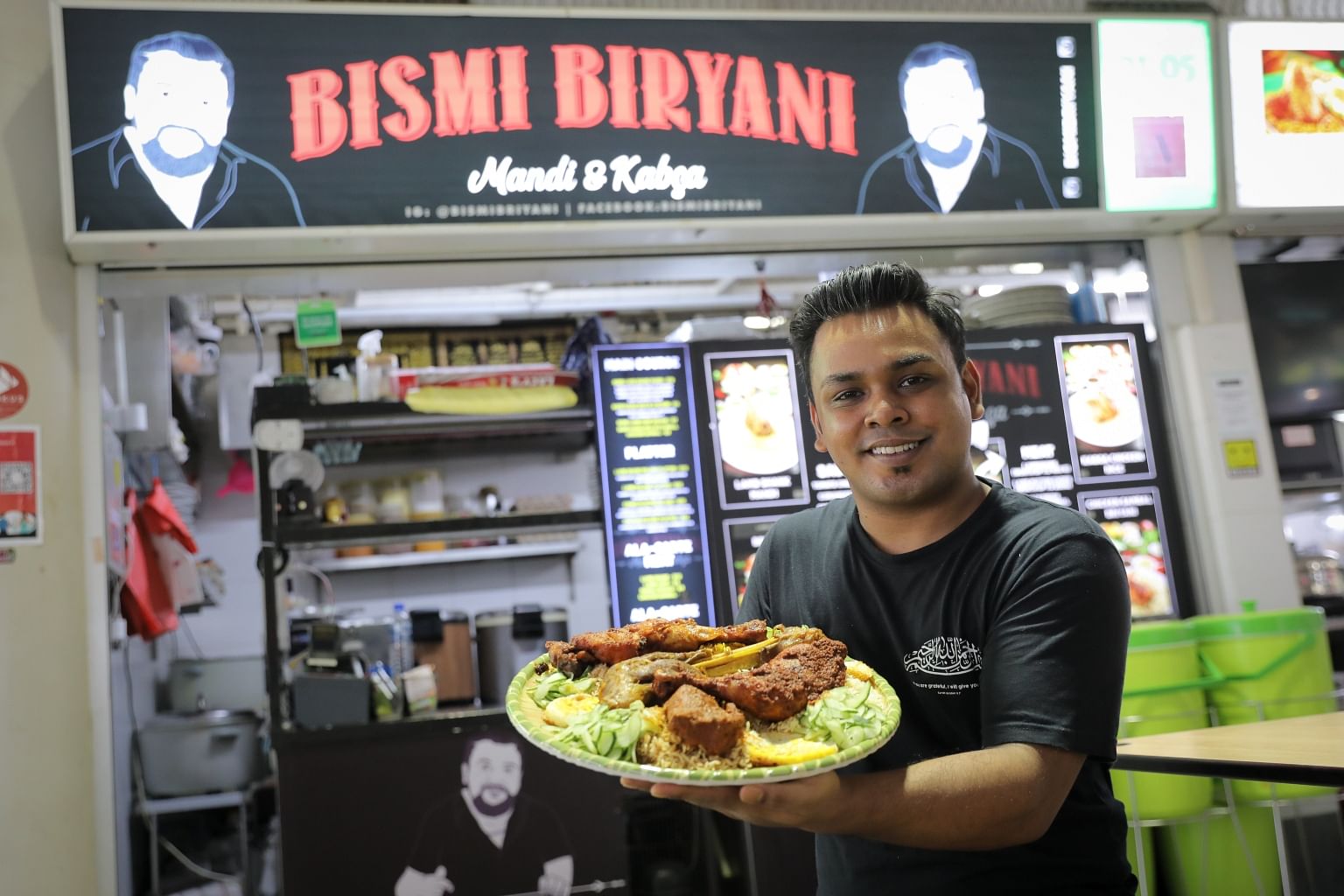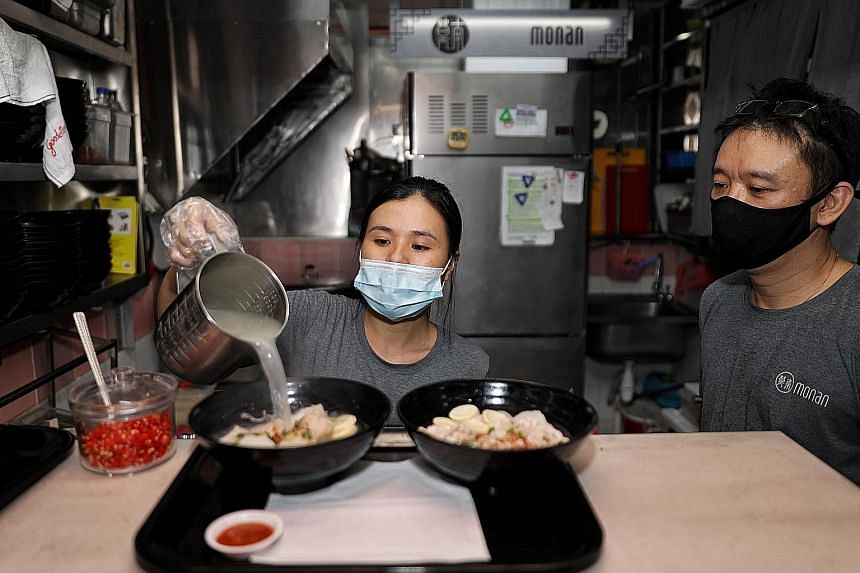Eye on hawker scene
Young guns up their game
Some young newcomers are joining the hawker trade with passion, vision and creative spins on traditional fare
Sign up now: Weekly recommendations for the best eats in town

Responding to customers' feedback, Mr Fabian Tan changed his menu four times during the first four months of operations at his burger stall.
ST PHOTO: JASON QUAH
Follow topic:
With the successful inclusion of Singapore's hawker culture on Unesco's list of intangible cultural heritage, there has been plenty of discussion over its longevity and sustainabiliy.
There has also been much bellyaching over why so few newcomers are willing to take up the trade.
But there are bright spots on the horizon, with a smattering of young and savvy hawkers entering the scene and shaking it up with creative offerings.
The Sunday Times speaks to three new first-time hawkers - from hawker incubation programmes - who are dishing out traditional fare with a modern spin.
Enticing customers with good food, reasonable pricing
In the first four months of operations at his burger stall Skirt And Dirt, 32-year-old Fabian Tan changed his menu four times.
His best-selling Cheese Skirt Beef Burger ($6.80) - which gets its name from a melted ring of cheese that fans out like a skirt - is the sole constant since day one.
A duck confit burger was axed as it received polarising responses, while a fish burger with tropical salsa ($5.80) was removed, then reinstated, by popular request.
Other current items include the Big Bad Wolf's Pork Burger ($6.80) and Cheesy Chicken Katsu Burger ($4.80).
The set meal, which costs $2 more, includes two sides - soup of the day, garden salad or Cajun fries.
"I'm still trying to see what else can be done and am playing around with cost as we cannot be too expensive," says Mr Tan, a graduate of At-Sunrice GlobalChef Academy who was a senior sous chef with One Faber Group.
Hoping to ditch long working hours and start his own business, Mr Tan, who is married, joined the hawker trade as a test bed for his eventual goal to open a cafe or restaurant. He now pulls 12-hour days, which he says are shorter compared with his previous job.
He first did his research by observing and asking stallholders how much they sell, their profit margins and when traffic flow is strongest.
He says: "You have to understand what the market is like and adjust accordingly. Initially, I expected a younger crowd of diners, but 50 per cent of my customers are above 40."
His stall now gets a good midafternoon crowd, with a steady stream of orders even when the usually bustling hawker centre is quiet. This is because he offers a weekday value burger at $4, to attract customers at the off-peak hour of 3pm.
-
SKIRT AND DIRT
WHERE: 02-66 Tiong Bahru Market & Food Centre, 30 Seng Poh Road; open: 11am to 7pm daily
Compared with what he took home as a salaried chef, Mr Tan says the difference is "not much", but there is greater risk involved during the "bad" months.
He acknowledges that being surrounded by heritage stalls in the storied Tiong Bahru Market & Food Centre is intimidating.
But he encourages new hawkers like himself to be flexible and innovative in getting people to try their food.
"Many customers might think twice about spending $6 on a meal and would go for cheaper, traditional dishes. But once they try your food, you have a 50 per cent chance of winning them over."
Pressing on despite naysayers and circuit breaker measures

On the fateful day last year when 24-year-old Sheik Mohammad triumphantly signed the agreement to open his stall at Yishun Park Hawker Centre, Prime Minister Lee Hsien Loong announced the start of the circuit breaker.
Mr Sheik was gutted. But he hunkered down and continued operating his family's home-based briyani business, which had been running for six months out of their Housing Board flat in Woodlands.
Shortly after, that, too, was suspended, when a temporary ban was imposed on those selling food and beverages from home.
Still undeterred, the gungho former Grab driver used the time to do more research and development to perfect his briyani.
When phase two started, he finally started renovation of his Arabic fusion stall at the food centre - but not before dealing with many naysayers along the way.
The ITE College West graduate says: "Many people asked me why I wanted to be a hawker and how I was going to sustain the business during this difficult time. They said I didn't have enough experience. I wanted to give up, but told myself that things would get better."
Things are certainly looking up for Mr Sheik, who completed his six-month incubation period at Yishun Park Hawker Centre in October and is now on a three-year lease as a full-fledged hawker.
He has gained a following for his Insta-worthy briyani platters - good for four people - with generous portions of rice and meat. Prices start at $22 for the chicken dulang platter.
The most popular order at his stall Bismi Briyani is the combo platter dulang ($30), with a bit of everything - his best-selling lamb shank, lamb chop, fried chicken and chicken sambal, with a choice of rice.
Three types of rice are available - classic briyani rice that is infused with spices and cooked with saffron and rose water; tomato-based kabsa rice; and mandi rice - the latter two inspired by Arabic dishes that Mr Sheik's father ate in India.
His father used to run a restaurant in India that was started by his grandparents. In Singapore, his parents used to run an Indian-Muslim stall in Sembawang, but now help out at his stall.
-
BISMI BRIYANI
WHERE: 01-05 Yishun Park Hawker Centre, 51 Yishun Avenue 11; open: 11am to 8pm, Tuesdays to Sundays, closed on Mondays
Mr Sheik - the youngest of three siblings - now pulls 16-hour shifts, working through the night till 5am to prepare the rice and slow-cooked lamb shank.
Hoping to inspire young hawkers like himself, he says: "Follow your heart and do whatever makes you happy. I'm still young and there's no harm in trying. I have worked towards it, no matter what people said.
"With the older generation of hawkers retiring, many of us are trying to change how hawker food used to be. We come with different ideas, we want to serve restaurant-quality dishes in a hawker centre setting. My wish is that people will encourage and support us."
Working hard to perfect star dish of 'alternative pork soup'

Despite marking his one-year anniversary as a hawker last Christmas, 41-year-old owner Liew Chuk Kee still considers his hawker stall, Monan Pork Soup, as his "stall zero".
"This is not my first stall because I am still testing and experimenting. I am doing something completely new," says the first-time hawker and former franchise business consultant.
The stall's name means "food" in Vietnamese (mon an), while its Chinese characters mean "south" - a reference to Singapore's location on the world map.
A year of meticulous research and development has gone into its star dish, which he calls an "alternative to pork soup". It tastes like a cross between pig's organ soup and bak kut teh, except it is not herbacious nor peppery.
Various cuts of pork are boiled for two to three hours to form the stock, a local take on what his Vietnam-born Singaporean wife Kim, 31, has been making for their family. The couple have two children, aged eight and six.
The signature Monan Pork Soup ($3.80) includes lashings of lean meat, pork belly, daikon and spinach. Other ingredients include handmade pork balls, and - rather uncommon - sliced egg sausage, made by piping egg into sausage skin.
Other options include pork organ soup ($4.50), pork leg soup ($5) and pork shabu soup ($5). The last dish is popular with the younger generation, says Mr Liew. Those who prefer a less peppery version of bak kut teh can opt for pork rib soup ($5.80).
Mr Liew chose his Chinatown location for its cosmopolitan crowd because he wants his dishes to appeal to a more "universal taste".
Before the Covid-19 pandemic hit, he managed to get visitors from Norway, Sweden and South Korea to try his product, and is hoping for tourists to return eventually.
The graduate from Upper Iowa University - with a double major in communications and management - currently sells enough to break even, after taking a "massive pay cut" from his previous job.
He adds: "I have saved enough to make sure I can feed my family for more than a year. If you see me employing staff, it means the business has become profitable."
-
MONAN PORK SOUP
WHERE: 02-137 Chinatown Complex Food Centre, 335 Smith Street; open: 11am to 7.30pm, Tuesdays to Saturdays, closed on Sundays and Mondays
INFO: Call 9834-9226 or go to www.facebook.com/monanporksoup
He has no plans for expansion yet, but is setting systems in place so that his business can be scaled up if opportunity knocks.
For those looking to enter the industry, he advises: "Make sure you are committed and that you have thought through the whole process. You have to understand the effort and time required, and roll your sleeves up."
"I'm not successful yet, but I've made it through the year without collapsing," he adds with a chuckle.
•Follow The Straits Times Food on Facebook and Instagram @straitstimesfood

